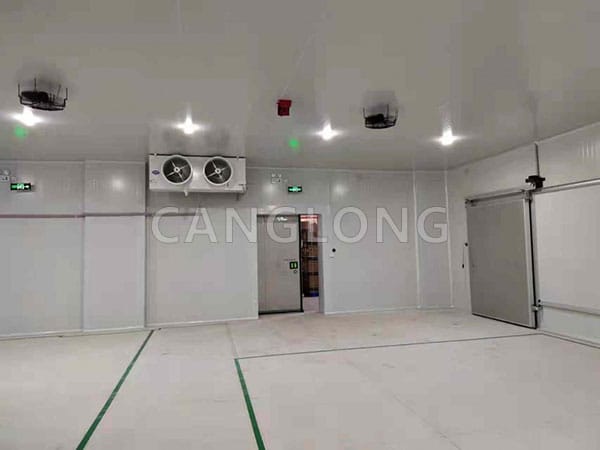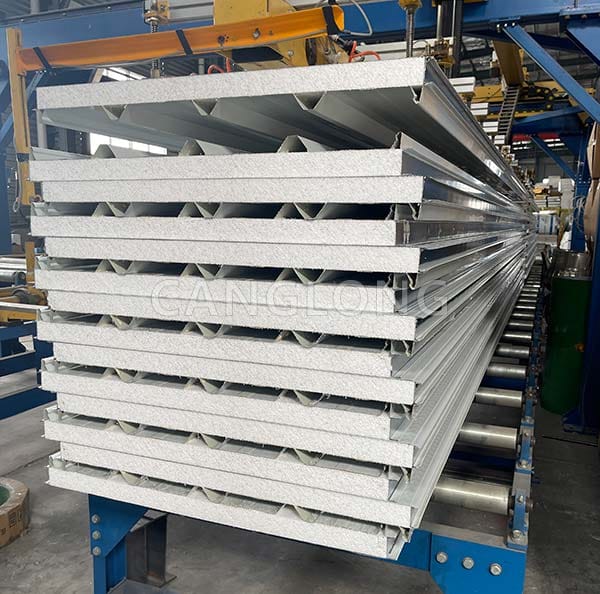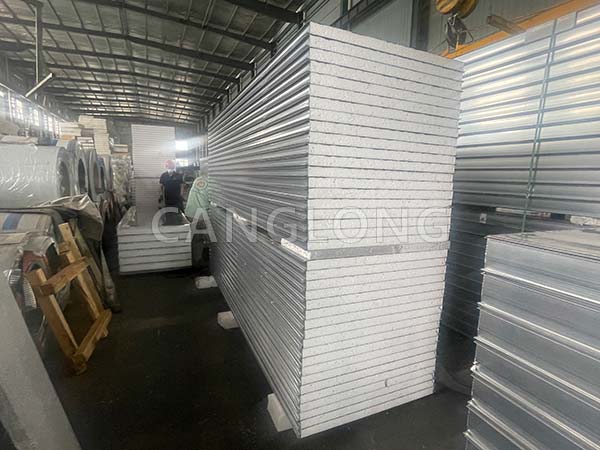Why has EPS roof insulation panels become the best choice for cold storage facilities?
According to data from the Food and Agriculture Organization of the United Nations, the global food cold chain market size has exceeded 3.2 trillion US dollars in 2023, and the annual growth rate of the pharmaceutical cold chain has exceeded 8%. As a core infrastructure, the construction efficiency, insulation performance and long-term cost of cold storage have become the focus of global users. In the construction of cold storage, the choice of roof insulation board directly determines the energy consumption, life and safety of the entire warehouse.
In recent years, EPS sandwich panels (expandable polystyrene foam sandwich panels) have rapidly penetrated the global cold storage market with their balanced performance and high cost-effectiveness, and are even regarded as innovative substitutes for traditional polyurethane (PU), rock wool and other panels. This article will dismantle the core advantages of EPS roof insulation panels and reveal how China Canglong Group has become a hidden champion in the field of cold storage construction with its technological accumulation and global services.

1. The triple game of cold storage insulation, cost and safety
The core demand of cold storage is long-term stable temperature control, which puts forward strict requirements on the performance of roof insulation board:
- Thermal insulation: It needs to have low thermal conductivity (λ value), reduce cold loss, and reduce compressor energy consumption (accounting for 40%-60% of the operating cost of cold storage).
- Weather resistance: It needs to resist moisture and temperature fluctuations (such as the temperature difference between the inside and outside of the cold storage is often -30℃ to 40℃), avoid condensation, aging or deformation.
- Safety: It needs to meet the fire protection level (most countries in the world require cold storage to reach B1/B2 level) and impact resistance (the roof needs to withstand snow accumulation, equipment hoisting and other loads).
- Economical: It needs to take into account the initial construction cost and the life cycle cost of more than 20 years, and adapt to the differentiated needs of different regions (such as high temperature and humidity in Southeast Asia, low temperature and dryness in Europe).
Among traditional boards, polyurethane (PU) has a low thermal conductivity (about 0.022W/(m·K)), but it is expensive (about 1.5 times that of EPS) and has poor flame retardancy (pure PU has a combustion grade of only B3). Rock wool is fireproof (Grade A), but it has a high density (150-200kg/m³), high water absorption (prone to insulation failure), and time-consuming construction (requires additional fixing brackets). Although XPS extruded board has good moisture resistance, its thermal conductivity is slightly higher than EPS (0.028-0.033W/(m·K)), and it is brittle and easy to crack. In this context, EPS sandwich panels have become the mainstream choice for cold storage roofs around the world with their comprehensive cost-effectiveness and adaptability.

2. Why is EPS roof insulation panels the optimal solution for cold storage?
EPS sandwich panels are building materials composed of two layers of metal panels (color steel plates/stainless steel plates) filled with EPS foam core materials. Its advantages have been repeatedly verified in global cold storage practices:
2.1 Excellent thermal insulation performance, energy consumption reduced by 30%+
The thermal conductivity of EPS is only 0.035-0.041W/(m·K) (ordinary EPS). By optimizing the foaming process (such as adding flame retardants and upgrading closed-cell structures), the thermal conductivity of EPS sandwich panels of leading companies such as Canglong Group can be reduced to 0.028-0.032W/(m·K), close to the PU level. More importantly, the EPS core material is an independent closed-cell structure, which hardly absorbs water (water absorption rate <0.1%), and long-term use will not cause the thermal insulation performance to decay due to moisture, which is far better than rock wool (water absorption rate >1%) and ordinary XPS (water absorption rate 0.3%-0.5%). In high-humidity areas around the world (such as Southeast Asia and Southern Europe), the long-term thermal insulation properties of EPS sandwich panels can directly reduce the energy consumption of cold storage by more than 30%.
2.2 Significant cost advantages, more cost-effective throughout the life cycle
From the initial construction point of view, the unit price of EPS sandwich panel is only 2/3 of PU and 1.2 times of rock wool, and no additional fireproof coating or waterproofing treatment is required (rock wool needs to be coated with waterproof mortar, and PU needs to add a flame retardant layer), and the overall cost is reduced by 20%-40%. In the long run, the lightweight of EPS (density of only 30-50kg/m³) reduces the demand for roof load-bearing structures and can save 15%-20% of steel. At the same time, its modular design supports fast installation (a single board only takes 10 minutes to splice), and the construction period is shortened by 40% compared with traditional construction, which indirectly reduces labor and time costs. In cold storage projects in Europe and the Middle East that are sensitive to construction periods, EPS’s low cost and fast delivery have become core competitiveness.
2.3 Double improvement in safety and adaptability, adaptable to a variety of complex scenarios
The metal panel of the EPS roof insulation panels can be selected from color steel plate (conventional), stainless steel (corrosion-resistant) or aluminum-magnesium-manganese plate (wind-resistant), which can be customized according to the cold storage environment. For example, stainless steel panels are selected in humid areas, and aluminum-magnesium-manganese plates are selected in high wind pressure areas. Its lightweight characteristics also reduce the requirements for foundations, and it is especially suitable for areas with high land costs or complex geological conditions (such as Japan and Southeast Asia). In addition, the combustion performance of EPS can reach B2 level (self-extinguishing 3 seconds away from the fire). Although it is slightly lower than the B1 level of PU, it can be upgraded to B1 level by adding flame retardants (such as bromine and phosphorus), which fully meets the cold storage fire protection standards of most countries in the world (such as EU EN 13501-1 and US ASTM E84).
2.4 Environmental protection and recyclability, in line with the trend of green cold chain
Under the global carbon reduction goal, the environmental protection of cold storage construction has become an important indicator. The main raw material of EPS is polystyrene (PS), which can be recycled and reused (recycling rate>90%), and there is no harmful gas emission during the production process (compared with PU’s foaming agent HCFCs, EPS uses carbon dioxide or pentane for foaming, which is more environmentally friendly). Companies such as Canglong Group have launched recycled EPS sandwich panels, mixing recycled PS particles into new materials in proportion, which not only reduces costs but also reduces white pollution, in line with the EU’s circular economy policy and China’s “14th Five-Year Plan” cold chain logistics development plan.

3. Canglong Group’s advantages
In the global EPS roof insulation panels market, China Canglong Group has become a hidden champion in the field of cold storage construction with 20 years of technology accumulation and global layout. Its core competitiveness is reflected in two dimensions:
3.1 Technology research and development: a leap from general to customized
Canglong Group has independently developed an intelligent foaming system, which can adjust EPS density (30-80kg/m³), thermal conductivity (0.025-0.040W/(m·K)) and fire rating (B1-B2) according to customer needs, and even develops ultra-low temperature special EPS for low-temperature cold storage (below -30℃), and improves freeze-thaw resistance by optimizing the pore structure. In addition, its metal panel adopts a continuous roll forming process, with optional thickness from 0.4mm to 1.2mm, and the surface is pre-coated with fluorocarbon paint (weather resistance over 25 years), which is suitable for different climate zones around the world (such as high temperature in the Middle East and extreme cold in Northern Europe).
3.2 Customized service: localized design + rapid response
Canglong Group provides one-stop service for design, production, transportation, and installation guidance. For cold storage projects, its team can provide customized design solutions based on local climate data (such as rainfall and wind load), and pass international certifications such as ISO 9001, CE, and SGS to ensure that the products meet global standards. For example, for a 30,000-ton cold storage project for a food company in the Philippines, the Canglong team used reinforced metal panels and wind-resistant clamps based on the frequent typhoons in the local area. After the project was delivered, it was tested by Typhoon Dusurui and the roof was not deformed or leaked.

4. Conclusion
Today, with the rapid development of the global cold chain industry, EPS roof insulation panels are changing from optional solutions to the best solutions with their balanced advantages of insulation, cost, safety, and environmental protection. With technological innovation and customized services, Canglong Group has not only created higher value for customers, but also promoted the integration of China’s cold storage construction standards with international standards.
In the future, with the deepening of the “Belt and Road” initiative, Canglong Group is expected to use EPS sandwich panels as a fulcrum to reshape the global cold storage construction market. After all, in the era of efficient, low-cost and sustainable cold chain, the dual-wheel drive of technology and services is the core code for enterprises to take the lead.
